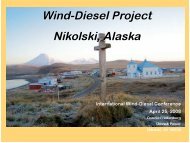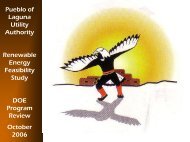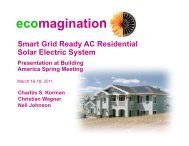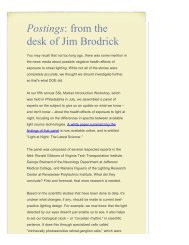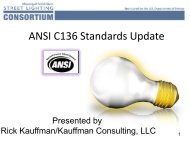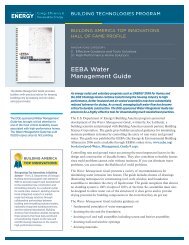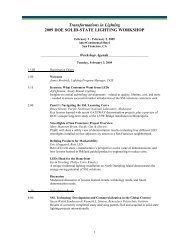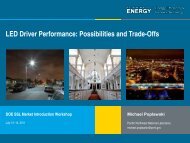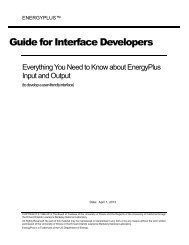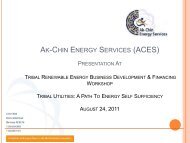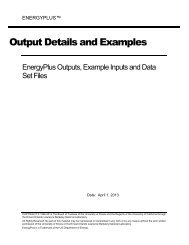Unvented, Conditioned Attics - U.S. Department of Energy
Unvented, Conditioned Attics - U.S. Department of Energy
Unvented, Conditioned Attics - U.S. Department of Energy
You also want an ePaper? Increase the reach of your titles
YUMPU automatically turns print PDFs into web optimized ePapers that Google loves.
BUILDING TECHNOLOGIES PROGRAM<br />
BUILDING AMERICA TOP INNOVATIONS<br />
HALL OF FAME PROFILE<br />
INNOVATIONS CATEGORY:<br />
1. Advanced Technologies and Practices<br />
1.1 Building Science Solutions<br />
<strong>Unvented</strong>, <strong>Conditioned</strong> <strong>Attics</strong><br />
The additional heat loss and gain <strong>of</strong> ducts<br />
in unconditioned, vented attics increases<br />
energy use for heating and cooling 10%.<br />
Additionally, duct air leakage has been<br />
measured to commonly exceed 20% <strong>of</strong><br />
conditioned air flow, which results in a<br />
significant energy loss when ducts are<br />
in unconditioned space. In addition to<br />
influencing builders across the country<br />
to adopt unvented, conditioned attics,<br />
Building America research has helped<br />
influence code acceptance <strong>of</strong> this<br />
innovation since 2006.<br />
BUILDING AMERICA<br />
TOP INNOVATIONS<br />
Recognizing Top Innovations in Building<br />
Science – The U.S. <strong>Department</strong> <strong>of</strong> <strong>Energy</strong>’s<br />
Building America program was started in<br />
1995 to provide research and development<br />
to the residential new construction and<br />
remodeling industry. As a national center<br />
for world-class research, Building America<br />
funds integrated research in marketready<br />
technology solutions through<br />
collaborative partnerships between<br />
building and remodeling industry leaders,<br />
nationally recognized building scientists,<br />
and the national laboratories. Building<br />
America Top Innovation Awards recognize<br />
those projects that have had a pr<strong>of</strong>ound<br />
or transforming impact on the new and<br />
retr<strong>of</strong>it housing industries on the road to<br />
high-performance homes.<br />
The preference for a large segment <strong>of</strong> the U.S. housing industry has been<br />
to locate HVAC systems in unconditioned attics, but this is highly inefficient.<br />
Building America research has demonstrated unvented, conditioned attics<br />
can substantially improve energy performance while allowing home builders<br />
to continue locating HVAC systems in the attic space.<br />
Traditionally, building codes have required attic ventilation. The intended<br />
purpose was to allow warm air and moisture to escape. Vented attics can be<br />
effective, as long as HVAC ducts are not located in them and the ceiling deck is<br />
well air sealed and insulated. These are significant challenges. First, the housing<br />
industry has demonstrated a strong preference for locating HVAC systems in<br />
attic spaces above insulated ceilings to accommodate design and cost concerns.<br />
Second, typical ro<strong>of</strong> slopes <strong>of</strong>ten leave inadequate height at the top plates for<br />
full-depth insulation. Third, there are extensive penetrations and cracks that<br />
require air sealing and air barriers including attic hatches, flues, piping, lighting,<br />
wiring, chases, attic eaves, dropped ceilings, and knee walls. Air leakage that is<br />
not addressed can lead to several problems. The loss <strong>of</strong> conditioned air increases<br />
heating and cooling demand. Humid indoor air that escapes into the attic can<br />
condense on cold ro<strong>of</strong> sheathing, resulting in potential moisture problems.<br />
Warm air that escapes into the attic in winter can warm the ro<strong>of</strong> deck and<br />
increase the risk <strong>of</strong> ice dams.<br />
When the HVAC system is located in a<br />
vented attic, it is exposed to extremes <strong>of</strong><br />
hot and cold. The energy needed for air<br />
conditioning and heating typically goes<br />
up 10% when ducts are in the attic (Ueno<br />
2003). Furthermore, leaky ducts can lose<br />
as much as 20% <strong>of</strong> conditioned air flow<br />
to the attic (BSC 2009). Oversized heating<br />
and cooling units are <strong>of</strong>ten installed to<br />
make up for the inefficiency <strong>of</strong> leaky<br />
ducts, further increasing the purchase<br />
cost and energy bills. Leaky ducts can also<br />
contribute to condensation and mold.<br />
“<strong>Unvented</strong> attics make a lot <strong>of</strong><br />
sense. In humid climates, venting<br />
attics brings a great deal <strong>of</strong><br />
moisture into the structure. In cold<br />
climates, venting attics brings in<br />
a great deal <strong>of</strong> snow. Not venting<br />
makes these problems go away.”<br />
Joe Lstiburek,<br />
Building Science Corporation
BUILDING AMERICA TOP INNOVATIONS HALL OF FAME PROFILE<br />
Insulating and air sealing along the ro<strong>of</strong> line <strong>of</strong>fers several advantages over<br />
insulating along the ceiling deck:<br />
• <strong>Energy</strong> Savings - An unvented attic is warmer in winter and cooler in summer,<br />
reducing the HVAC load. The equipment will be more durable and more<br />
efficient, especially if ductwork is in the attic (Rudd 2005).<br />
• Moisture Resistance - The attic will stay dry, avoiding problems with mold and<br />
wood rot, and thus can serve as living or storage space.<br />
• Disaster Resistance - Ro<strong>of</strong>s over unvented attics are less likely to be blown <strong>of</strong>f in<br />
high winds because the wind cannot readily enter the attic. In addition, a house<br />
in wildfire zones is less likely to catch fire from floating embers since there are<br />
no s<strong>of</strong>fit vents for the embers to enter. In coastal areas, an unvented ro<strong>of</strong><br />
keeps out wind-driven rain and better protects metal connectors in the ro<strong>of</strong><br />
assembly against salt spray and corrosion (Lstiburek 2006).<br />
<strong>Unvented</strong>, conditioned attics and their advantages have been extensively<br />
documented with Building America field tests in numerous states including<br />
Minnesota, Massachusetts, and California (Rudd 2005). In the process, builders<br />
have worked with researchers to identify combinations <strong>of</strong> materials that<br />
perform well in all climate zones.<br />
Key Lessons Learned<br />
• The acceptance <strong>of</strong> unvented, conditioned attics continues to grow among<br />
builders and building <strong>of</strong>ficials. Code requirements vary across the country.<br />
The IRC has permitted unvented, conditioned attics since 2006, with<br />
certain requirements.<br />
• The ro<strong>of</strong> deck in an unvented attic must be exceptionally airtight.<br />
• Insulation approaches for unvented attics vary by climate. Fibrous insulation<br />
(e.g., batt or blown-in) can be installed under the ro<strong>of</strong> deck in the hot-dry<br />
climate zone, but this will cause moisture problems in all other climates<br />
(Straube and Grin 2010). Humid or cold climates require either rigid<br />
foam insulation above the ro<strong>of</strong> deck (to keep its temperature above 45°F<br />
throughout the year) or spray foam insulation under the ro<strong>of</strong> deck (to keep<br />
interior moist air from contacting it).<br />
• Closed-cell spray foam can be used in any climate. It has the highest R-value<br />
<strong>of</strong> any insulation material, is a vapor retarder, and provides a tight air seal.<br />
• In cold climates, installing enough rigid or spray foam insulation to reach<br />
the recommended R-value may be expensive. To reduce costs, foam can be<br />
supplemented with less expensive insulation materials. However, to ensure<br />
moisture control, care must be taken to use the climate-specific proportions<br />
<strong>of</strong> foam and non-foam insulation (Straube et al. 2010).<br />
• All foam on the interior should be protected by a fire-rated material, such as<br />
½-inch gypsum board.<br />
• Vapor retarders on the floors <strong>of</strong> unvented attics are prohibited under the<br />
2009 International Residential Code ® (IRC).<br />
“We were already testing and getting<br />
a tight duct system, but now it is all<br />
inside the building envelope, and in<br />
a hot, humid climate this makes a<br />
tremendous difference.”<br />
John Friesenhahn,<br />
Owner <strong>of</strong> Imagine Homes <strong>of</strong> San Antonio<br />
REFERENCES<br />
Building <strong>Energy</strong> Codes Resource Center. 2011.<br />
<strong>Conditioned</strong> <strong>Attics</strong> - Code Notes, Article #1520.<br />
http://resourcecenter.pnl.gov/cocoon/morf/<br />
ResourceCenter/article/1520<br />
BSC. 2009. Ducts in <strong>Conditioned</strong> Space. Info-602,<br />
Building Science Corporation. www.buildingscience.<br />
com/documents/information-sheets/informationsheet-ducts-in-conditioned-space<br />
Lstiburek, J. 1999. “Why <strong>Unvented</strong> <strong>Attics</strong> Are Not<br />
a Crazy Idea.” www.asifoam.com/library/Joseph_<br />
Lstiburek_-unvented_attics,__7-11-99.pdf<br />
Lstiburek, J. 2006. Understanding Attic<br />
Ventilation, BSD-102, Building Science<br />
Corporation. www.buildingscience.com/<br />
documents/digests/bsd-102-understanding-atticventilation?topic=doctypes/digests<br />
Rudd, A. 2005. “Field Performance <strong>of</strong> <strong>Unvented</strong><br />
Cathedralized (UC) <strong>Attics</strong> in the USA.” Journal<br />
<strong>of</strong> Building Physics. http://jen.sagepub.com/<br />
content/29/2/145.abstract<br />
Straube, J. 2006. Wood Pitched Ro<strong>of</strong><br />
Construction, BSD-115 Building Science<br />
Corporation. www.buildingscience.com/<br />
documents/digests/bsd-115-wood-pitched-ro<strong>of</strong>construction?topic=doctypes/digests<br />
Straube, J. and A.Grin. 2010. Building America<br />
Special Research Project: High-R<br />
Ro<strong>of</strong>s Case Study Analysis, RR-1006, Prepared<br />
for U.S. <strong>Department</strong> <strong>of</strong> <strong>Energy</strong><br />
by Building Science Corporation.<br />
www.buildingscience.com/documents/reports/<br />
rr-1006-ba-high-r-ro<strong>of</strong>s-case-study-analysis<br />
Straube et al. 2010. RR-1001, Moisture-Safe<br />
<strong>Unvented</strong> Wood Ro<strong>of</strong> Systems, Building<br />
Science Corporation Research Report – 1001.<br />
www.buildingscience.com/documents/reports/rr-<br />
1001-moisture-safe-unvented-wood-ro<strong>of</strong>-systems<br />
Ueno, K. 2003. <strong>Unvented</strong> Ro<strong>of</strong> Summary<br />
Article. RR-0301e, Building Science Corporation.<br />
www.buildingscience.com/documents/reports/<br />
rr-0301-unvented-ro<strong>of</strong>-summary-article/<br />
DOE Building Technologies Program<br />
www.buildings.gov<br />
Building America Solutions Center<br />
www.buildingamerica.gov/solutionscenter<br />
PNNL-SA-90548 January 2013<br />
www.BuildingAmerica.gov



